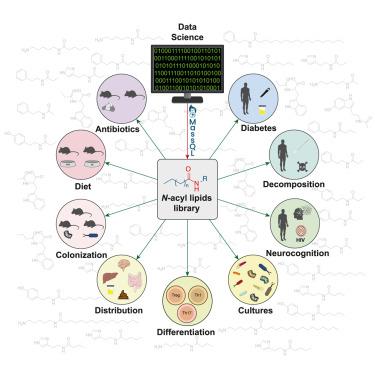The microbiome diversifies long- to short-chain fatty acid-derived N-acyl lipids
IF 42.5
1区 生物学
Q1 BIOCHEMISTRY & MOLECULAR BIOLOGY
引用次数: 0
Abstract
N-Acyl lipids are important mediators of several biological processes including immune function and stress response. To enhance the detection of N-acyl lipids with untargeted mass spectrometry-based metabolomics, we created a reference spectral library retrieving N-acyl lipid patterns from 2,700 public datasets, identifying 851 N-acyl lipids that were detected 356,542 times. 777 are not documented in lipid structural databases, with 18% of these derived from short-chain fatty acids and found in the digestive tract and other organs. Their levels varied with diet and microbial colonization and in people living with diabetes. We used the library to link microbial N-acyl lipids, including histamine and polyamine conjugates, to HIV status and cognitive impairment. This resource will enhance the annotation of these compounds in future studies to further the understanding of their roles in health and disease and to highlight the value of large-scale untargeted metabolomics data for metabolite discovery.

微生物群使长链到短链脂肪酸衍生的n -酰基脂质多样化
n -酰基脂是多种生物过程的重要介质,包括免疫功能和应激反应。为了增强基于非靶向质谱的代谢组学对n -酰基脂质的检测,我们创建了一个参考谱库,从2700个公共数据集中检索n -酰基脂的模式,确定了851种n -酰基脂质的检测356,542次。777种没有在脂质结构数据库中记录,其中18%来自短链脂肪酸,存在于消化道和其他器官中。它们的水平随着饮食和微生物定植以及糖尿病患者而变化。我们使用该文库将微生物n -酰基脂,包括组胺和多胺偶联物,与HIV状态和认知障碍联系起来。该资源将在未来的研究中加强对这些化合物的注释,以进一步了解它们在健康和疾病中的作用,并突出大规模非靶向代谢组学数据对代谢物发现的价值。
本文章由计算机程序翻译,如有差异,请以英文原文为准。
求助全文
约1分钟内获得全文
求助全文
来源期刊

Cell
生物-生化与分子生物学
CiteScore
110.00
自引率
0.80%
发文量
396
审稿时长
2 months
期刊介绍:
Cells is an international, peer-reviewed, open access journal that focuses on cell biology, molecular biology, and biophysics. It is affiliated with several societies, including the Spanish Society for Biochemistry and Molecular Biology (SEBBM), Nordic Autophagy Society (NAS), Spanish Society of Hematology and Hemotherapy (SEHH), and Society for Regenerative Medicine (Russian Federation) (RPO).
The journal publishes research findings of significant importance in various areas of experimental biology, such as cell biology, molecular biology, neuroscience, immunology, virology, microbiology, cancer, human genetics, systems biology, signaling, and disease mechanisms and therapeutics. The primary criterion for considering papers is whether the results contribute to significant conceptual advances or raise thought-provoking questions and hypotheses related to interesting and important biological inquiries.
In addition to primary research articles presented in four formats, Cells also features review and opinion articles in its "leading edge" section, discussing recent research advancements and topics of interest to its wide readership.
 求助内容:
求助内容: 应助结果提醒方式:
应助结果提醒方式:


